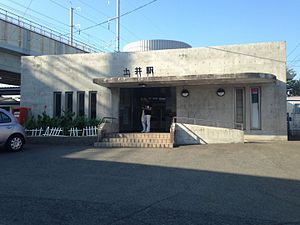Doi Station (Fukuoka)
JD 09 Doi Station 土井駅 | |
|---|---|
 Doi Station in 2015 | |
| Location | 3-23 Doi, Higashi-ku, Fukuoka-shi, Fukuoka-ken 813-0032 Japan |
| Coordinates | 33°38′06″N 130°27′58″E / 33.63500°N 130.46611°ECoordinates: 33°38′06″N 130°27′58″E / 33.63500°N 130.46611°E |
| Operated by | |
| Line(s) | ■ Kashii Line |
| Distance | 16.4 km from Saitozaki |
| Platforms | 2 side platforms |
| Tracks | 2 |
| Construction | |
| Structure type | At grade |
| Bicycle facilities | Designated parking area for bikes |
| Disabled access | No - platforms linked by level crossing with steps at both ends |
| Other information | |
| Status | Remotely managed station |
| Website | Official website |
| History | |
| Opened | 1 January 1904 |
| Passengers | |
| FY2016 | 1,364 daily |
| Rank | 129th (among JR Kyushu stations) |
| Location | |
 JD 09 Doi Station Location within Japan | |
Doi Station (土井駅, Doi-eki) is a railway station on the Kashii Line operated by JR Kyushu in Higashi-ku, Fukuoka, Fukuoka Prefecture, Japan.[1]
Lines[]
The station is served by the Kashii Line and is located 16.4 km from the starting point of the line at Saitozaki.[2]
Station layout[]
The station, which is unstaffed, consists of two side platforms serving two tracks. A station building, a modern concrete structure, houses a waiting area and automatic ticket vending machines. There is a ramp up to the station building from the main road but access to the opposite side platform is by means of a level crossing with steps onto the platforms at both ends. A designated waiting area is provided outside the station. The elevated tracks of the Sanyo Shinkansen run over a part of the station platforms.[2][3]
Adjacent stations[]
| ← | Service | → | ||
|---|---|---|---|---|
| Kashii Line | ||||
| JD 08 Maimatsubara | Local | JD 10 Iga | ||
History[]
The station was opened on 1 January 1904 by the private Hakata Bay Railway as an intermediate station on a track it opened between Saitozaki and Sue. On 19 September 1942, the company, now renamed the Hakata Bay Railway and Steamship Company, with a few other companies, merged into the Kyushu Electric Tramway. Three days later, the new conglomerate, which had assumed control of the station, became the Nishi-Nippon Railroad (Nishitetsu). On 1 May 1944, Nishitetsu's track from Saitozaki to Sue and the later extensions to Shinbaru and Umi were nationalized. Japanese Government Railways (JGR) took over control of the station and the track which served it was designated the Kashii Line. With the privatization of Japanese National Railways (JNR), the successor of JGR, on 1 April 1987, JR Kyushu took over control of the station.[4][5]
On 14 March 2015, the station, along with others on the line, became a remotely managed "Smart Support Station". Under this scheme, although the station became unstaffed, passengers using the automatic ticket vending machines or ticket gates could receive assistance via intercom from staff at a central support centre.[6]
Passenger statistics[]
In fiscal 2016, the station was used by an average of 1,364 passengers daily (boarding passengers only), and it ranked 129th among the busiest stations of JR Kyushu.[7]
References[]
- ^ "JR Kyushu Route Map" (PDF). JR Kyushu. Retrieved 3 March 2018.
- ^ Jump up to: a b Kawashima, Ryōzō (2013). 図説: 日本の鉄道 四国・九州ライン 全線・全駅・全配線・第3巻 北九州 筑豊 エリア [Japan Railways Illustrated. Shikoku and Kyushu. All lines, all stations, all track layouts. Volume 3 Kyushu Chikuhō area] (in Japanese). Kodansha. pp. 31, 71. ISBN 9784062951623.
- ^ "土井駅" [Doi]. hacchi-no-he.net. Retrieved 5 March 2018.
- ^ Ishino, Tetsu; et al., eds. (1998). 停車場変遷大事典 国鉄・JR編 [Station Transition Directory - JNR/JR] (in Japanese). I. Tokyo: JTB Corporation. p. 220. ISBN 4533029809.
- ^ Ishino, Tetsu; et al., eds. (1998). 停車場変遷大事典 国鉄・JR編 [Station Transition Directory - JNR/JR] (in Japanese). II. Tokyo: JTB Corporation. p. 695. ISBN 4533029809.
- ^ "香椎線の各駅が「Smart Support Station」に変わります" [Stations on the Kashii Line to become "Smart Support Stations"] (PDF). JR Kyushu. 22 December 2014. Retrieved 5 March 2018.
- ^ "駅別乗車人員上位300駅(平成28年度)" [Passengers embarking by station - Top 300 stations (Fiscal 2016)] (PDF). JR Kyushu. 31 July 2017. Archived from the original (PDF) on 1 August 2017. Retrieved 3 March 2018.
| Wikimedia Commons has media related to Doi Station (Fukuoka). |
External links[]
- Doi (JR Kyushu)(in Japanese)
- Stations of Kyushu Railway Company
- Railway stations in Fukuoka Prefecture
- Railway stations in Japan opened in 1904
- Fukuoka Prefecture railway station stubs
